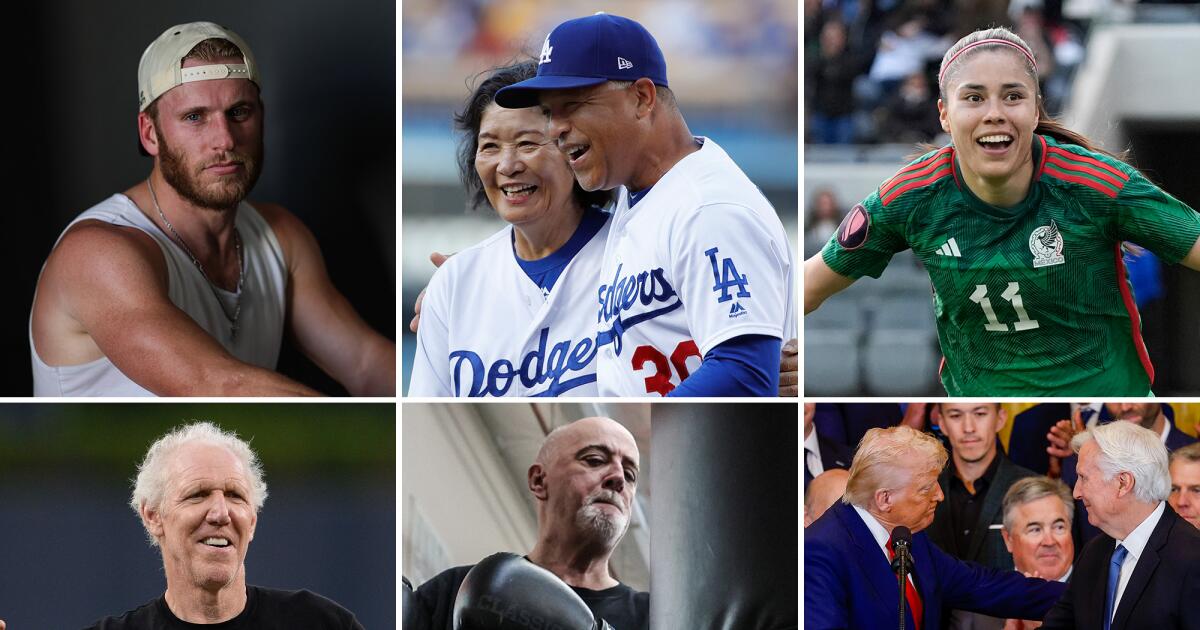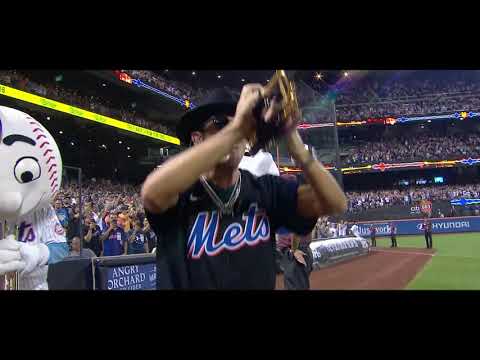Proving yet again that nobody combines excitement and entertainment like these guys, this week the Dodgers made baseball’s most important winter deal.
They acquired Timmy Trumpet.
In real life he’s an Australian impresario who, surprise, plays the trumpet. But in the breathtaking world of ninth-inning baseball, he’s the game’s most popular soundtrack.
It is Timmy Trumpet who plays the chillingly inspiring solo from “Narco” that accompanies closer Edwin Díaz from the bullpen to the mound. For the seven seasons Díaz played for the New York Mets, it was the coolest entrance song in the big leagues, creating the most intimidating scene in any ballpark anywhere.
And now it’s coming to Dodger Stadium, as the Dodgers and Díaz agreed this week to a three-year, $69-million contract that will include Timmy Trumpet rattling the bejeezus out of visiting teams who must be asking, do the Dodgers really have to buy everything?
Was it not enough for them to sign the best reliever in baseball? Did they also have to bring in the best ninth-inning atmosphere in baseball?
Yes, they do, and yes, they did, and if you haven’t witnessed the Edwin Díaz/Timmy Trumpet duet, Google it once and you’ll be hooked.
Upon his signing, the social media of Dodgers fans was filled with trumpet emojis. Even the venerable Dieter Ruehle posted a video of him playing the trumpet solo on the keyboard.
In the pantheon of Dodgers entrance and walk-up songs, this immediately moves to the top of a playlist that has become ingrained in the hearts of fans who have come to associate the brief clips of music with the enduring heroics of their players.
From the late great organist Nancy Bea Hefley playing “Master of the House” for Orel Hershiser … to Kenley Jansen revving up the crowd with “California Love” … there is a rich history of Dodgers being identified by their accompanying music.
This team is no different, with several songs reaching iconic status simply based on the splendid feats that spring from their chords.
One man’s nine best songs, in order of impact.
1. ”Narco” for Edwin Díaz
It is already the best Dodgers song and he hasn’t even shown up yet. Trust me.
Díaz chose it in 2018 when he played for the Seattle Mariners. When that became his 57-save breakout season, his wife advised him to keep it. After being traded to the Mets, he became so loyal to the song, he even asked it to be played in an empty Citi Field during the 2020 pandemic season.
In ensuing seasons the scene went viral, highlighted by an actual performance by Timmy Trumpet last summer. Expect the Dodgers to invite Mr. Trumpet to Chavez Ravine, maybe even for the opening series. Like so many things they have staged during these consecutive championship seasons, it will be an event.
2. ”We Are Young” for Clayton Kershaw
The pitcher is retired, but the song still warrants celebration on an emeritus basis.
Quick question: Has any Dodgers entrance hymn endured as long as this one? Dodgers fans have adult children as old as this song.
Another quick question: When you heard this song for the last time in the final months of this past season, did you surprisingly feel tears?
The perfect anthem for the perfect pitcher.
3. ”Bailalo Rocky” for Roki Sasaki
It’s not really a song, it’s a chant, bailalorocky, bailalorocky, bailalorocky with the “Rocky” sounding like, “Roki.”
It was chosen for the famously unhip Sasaki by Miguel Rojas in spring training and, by the time the kid pitcher returned from the disabled list to save playoff games, the fans were chanting it and dancing to it like few celebration songs in Chavez Ravine history.
“You can see it in Dodger Stadium … it was amazing,” Rojas told reporters before the World Series. “So electric, dancing on the bleachers in left-center field … I’m hoping everybody starts dancing to that song when Roki comes to pitch.”
4. ”Feeling Good” for Shohei Ohtani
Thank you, Michael Bublé, for singing what everybody is thinking every time Ohtani comes to the plate.
And thank you, Mamiko Tanaka, for making it happen.
“The coach of the Dodgers was nice enough to introduce me to Shohei, and I said to him, ‘Why did you choose my song?’” Bublé explained in an interview on “The Today Show.” “And very quickly he just turned to his wife … and it was his wife that chose it.”
Bublé added, “I’ll take it!”
He and about 4 million others.
5. ”Baila Conmigo” for Freddie Freeman
It played before Freeman’s game-winning grand slam in Game 1 of the 2024 World Series.
It played before Freeman’s game-winning home run in the 18th inning of Game 3 of this year’s World Series.
The horn solo at the beginning of this catchy tune has come to represent two words to Dodgers fans who now bounce to its beat.
Greatness coming.
6. “La Leche Materna” for Kiké Hernandez
Just like Hernandez’s Dodgers contributions, this tune saves its best for last.
The final 30 seconds of the song sound like, “Kiké, Kiké, Kiké” over and over again.
It’s weird, but also as powerfully effective as, say, a double play fly ball to end a World Series game.
7. A rotation of songs for Mookie Betts
Betts has walked out to a varied playlist, but his selections are included here because he can boast of one walk-up tune unmatched in baseball history.
He steps to the plate accompanied by an unreleased song written by Snoop Dogg just for him.
8. ”Amen” for Max Muncy
The chorus of this country song that accompanies Muncy to the plate appropriately begins, “Somebody say a prayer for me … ”
Considering all of his injury issues during his eight-year Dodgers career, fans have heeded that call.
Considering he holds the Dodgers record with 16 career postseason homers, those prayers have been answered.
9. ”Squabble Up” for Will Smith
His current Kendrick Lamar song is cool, but Smith is on this list in honor of a previous walk-up song that endeared him to Dodgers fans as that rare player who can laugh at himself.
This Will Smith once walked up to the theme from “The Fresh Prince of Bel-Air.”


